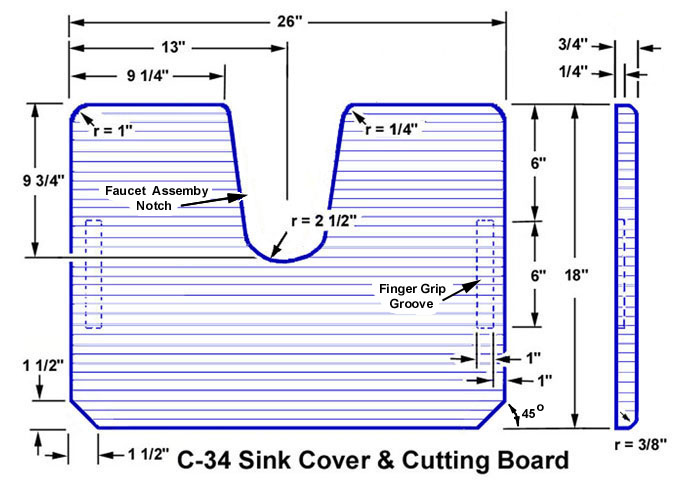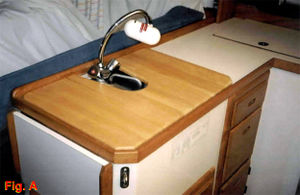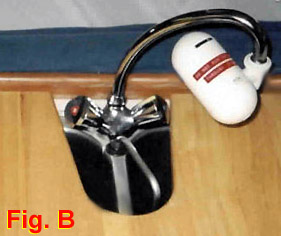Difference between revisions of "Galley Sink Cover"
(New page: Weal Sea's Sink Cover - Cutting Board Combo Need more counter space in the galley and maybe even a cutting board? The photos and the drawing shown here illustrate a galley project adapted...) |
|||
| Line 1: | Line 1: | ||
| − | Weal Sea's Sink Cover - Cutting Board Combo | + | ==Weal Sea's Sink Cover - Cutting Board Combo== |
| + | '''By Dan Harrington, ''Weal Sea'' #1289''' | ||
| − | Need more counter space in the galley and maybe even a cutting board? The photos and the drawing shown here illustrate a galley project adapted from our kitchen at home... a combination "sink cover-cutting board" designed so as to allow continued use of the sink to wash-out tumblers, discard liquids, etc. even when the sink is covered. (Also hides dirty dishes in a pinch!) Because the board can be flipped, one side is kept "neat" for display while the other side can be "used and abused" for cutting, etc. | + | [[Image:SinkCoverCuttingBoardPicture1A.jpg|thumb|350px]] |
| − | + | Need more counter space in the galley and maybe even a cutting board? The photos and the drawing shown here illustrate a galley project adapted from our kitchen at home... a combination "sink cover-cutting board" designed so as to allow continued use of the sink to wash-out tumblers, discard liquids, etc. even when the sink is covered. (Also hides dirty dishes in a pinch!) Because the board can be flipped, one side is kept "neat" for display while the other side can be "used and abused" for cutting, etc. | |
| − | |||
| + | ===Materials:=== | ||
You'll need a piece of solid hardwood measuring 18" x 26" x 3/4" (see drawing). * Because I was unable to find a hardwood "butcher block" cutting board that fit the above measurements, I ended up fabricating my own board. | You'll need a piece of solid hardwood measuring 18" x 26" x 3/4" (see drawing). * Because I was unable to find a hardwood "butcher block" cutting board that fit the above measurements, I ended up fabricating my own board. | ||
| − | I purchased two collapsible solid hardwood "TV snack tables" from Wal-Mart for about $10 each. These are normally sold in sets of 4 with a holding rack but can often be purchased as singles. The tops of these particular tables measured 21"x 15"x 3/4".< | + | I purchased two collapsible solid hardwood "TV snack tables" from Wal-Mart for about $10 each. These are normally sold in sets of 4 with a holding rack but can often be purchased as singles. The tops of these particular tables measured 21"x 15"x 3/4".<br> |
| − | [[Image:SinkCoverCuttingBoardPlans.jpg]]< | + | [[Image:SinkCoverCuttingBoardPlans.jpg]]<br> |
Board Fabrication: | Board Fabrication: | ||
| − | + | #Remove and discarded the TV snack table legs. | |
| + | #Using a table saw, square the edge on one side of each tabletop by cutting a 1/2" strip off one of its longest (21-inch) sides. | ||
| + | #Using a biscuit jointer, cut 3 or 4 biscuit grooves in the squared edge of each tabletop. (Tongue-and-groove methods can also be used to join the 2 tabletops together). | ||
| + | #Apply wood glue to the squared edges, insert wood biscuits, and then clamp the two tabletops together. | ||
| + | #Allow the newly fabricated 29"x 21"x 3/4" board to dry completely (24-48 hours). | ||
| + | #Sand surfaces to remove glue remnants and smooth the junction of the joined tabletops. (NOTE - You'll "finish sand" later.) | ||
| − | + | ===Cutting and Finishing:=== | |
| − | + | #Using a table saw, cut the newly fabricated board to measure 18" x 26". * | |
| − | + | #Cut off the two "galley-side" corners of the board at a 45-degree angle; 1-1/2" deep cuts. (See drawing) | |
| − | + | #Round off the two opposite "salon-side" corners of the board; radius = 1" | |
| − | + | #Cut the faucet assembly notch in the "salon-side" edge of the board. (See drawing for measurements) | |
| − | |||
| − | |||
| − | |||
| − | |||
| − | |||
| − | Cutting and Finishing: | ||
| − | |||
| − | |||
| − | |||
| − | |||
| − | |||
| − | |||
| − | |||
| − | |||
[[Image:SinkCoverCuttingBoardPicture1B.jpg]]<bk> | [[Image:SinkCoverCuttingBoardPicture1B.jpg]]<bk> | ||
| − | + | #STOP - Examine the board and decide which surface will to be used for "display" and which surface will to be used for "cutting". | |
| − | + | #Turn the "display" surface face up. Using a 3/8" quarter round blade, route the edge of faucet assembly notch and the entire perimeter of the board. | |
| − | + | #Turn the "cutting" surface face up. Using a 1" diameter rabbet blade, route a 6" long, 1/4" deep groove parallel to both lateral edges of the board about 1" in from the edge. (Note- These rabbets / grooves provide "finger grips" to assist in lifting and carrying the board. See drawing) | |
| − | + | #Finish the board by sanding and giving it 3 or 4 coats of varnish or polyurethane. | |
| − | |||
| − | |||
| − | |||
| − | |||
| − | |||
| + | ===Cautionary Note:=== | ||
Measurements given here are for my boat, a 1994 Mk I C-34. While the galley counter top and sink measurements of the MK I's appear standard, the timeworn woodworker's adage "measure twice and cut once" still has merit. Therefore, you should use the measurements in the drawing shown here to make a full-sized cardboard pattern of the project that you can test-fit on your boat. Since the board is designed to be flipped, don't forget to "flip" the pattern to test-fit both sides. | Measurements given here are for my boat, a 1994 Mk I C-34. While the galley counter top and sink measurements of the MK I's appear standard, the timeworn woodworker's adage "measure twice and cut once" still has merit. Therefore, you should use the measurements in the drawing shown here to make a full-sized cardboard pattern of the project that you can test-fit on your boat. Since the board is designed to be flipped, don't forget to "flip" the pattern to test-fit both sides. | ||
| − | Acknowledgment: | + | '''Acknowledgment:''' |
Many thanks to Ben Holland, a fellow C-34 owner and professional furniture craftsman for helping with this and other projects. | Many thanks to Ben Holland, a fellow C-34 owner and professional furniture craftsman for helping with this and other projects. | ||
| − | |||
| − | |||
| − | |||
| − | |||
Revision as of 16:27, 28 January 2009
Contents
Weal Sea's Sink Cover - Cutting Board Combo
By Dan Harrington, Weal Sea #1289
Need more counter space in the galley and maybe even a cutting board? The photos and the drawing shown here illustrate a galley project adapted from our kitchen at home... a combination "sink cover-cutting board" designed so as to allow continued use of the sink to wash-out tumblers, discard liquids, etc. even when the sink is covered. (Also hides dirty dishes in a pinch!) Because the board can be flipped, one side is kept "neat" for display while the other side can be "used and abused" for cutting, etc.
Materials:
You'll need a piece of solid hardwood measuring 18" x 26" x 3/4" (see drawing). * Because I was unable to find a hardwood "butcher block" cutting board that fit the above measurements, I ended up fabricating my own board.
I purchased two collapsible solid hardwood "TV snack tables" from Wal-Mart for about $10 each. These are normally sold in sets of 4 with a holding rack but can often be purchased as singles. The tops of these particular tables measured 21"x 15"x 3/4".

Board Fabrication:
- Remove and discarded the TV snack table legs.
- Using a table saw, square the edge on one side of each tabletop by cutting a 1/2" strip off one of its longest (21-inch) sides.
- Using a biscuit jointer, cut 3 or 4 biscuit grooves in the squared edge of each tabletop. (Tongue-and-groove methods can also be used to join the 2 tabletops together).
- Apply wood glue to the squared edges, insert wood biscuits, and then clamp the two tabletops together.
- Allow the newly fabricated 29"x 21"x 3/4" board to dry completely (24-48 hours).
- Sand surfaces to remove glue remnants and smooth the junction of the joined tabletops. (NOTE - You'll "finish sand" later.)
Cutting and Finishing:
- Using a table saw, cut the newly fabricated board to measure 18" x 26". *
- Cut off the two "galley-side" corners of the board at a 45-degree angle; 1-1/2" deep cuts. (See drawing)
- Round off the two opposite "salon-side" corners of the board; radius = 1"
- Cut the faucet assembly notch in the "salon-side" edge of the board. (See drawing for measurements)
- STOP - Examine the board and decide which surface will to be used for "display" and which surface will to be used for "cutting".
- Turn the "display" surface face up. Using a 3/8" quarter round blade, route the edge of faucet assembly notch and the entire perimeter of the board.
- Turn the "cutting" surface face up. Using a 1" diameter rabbet blade, route a 6" long, 1/4" deep groove parallel to both lateral edges of the board about 1" in from the edge. (Note- These rabbets / grooves provide "finger grips" to assist in lifting and carrying the board. See drawing)
- Finish the board by sanding and giving it 3 or 4 coats of varnish or polyurethane.
Cautionary Note:
Measurements given here are for my boat, a 1994 Mk I C-34. While the galley counter top and sink measurements of the MK I's appear standard, the timeworn woodworker's adage "measure twice and cut once" still has merit. Therefore, you should use the measurements in the drawing shown here to make a full-sized cardboard pattern of the project that you can test-fit on your boat. Since the board is designed to be flipped, don't forget to "flip" the pattern to test-fit both sides.
Acknowledgment:
Many thanks to Ben Holland, a fellow C-34 owner and professional furniture craftsman for helping with this and other projects.

